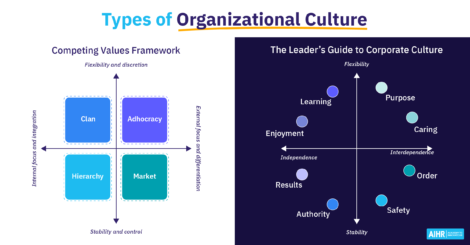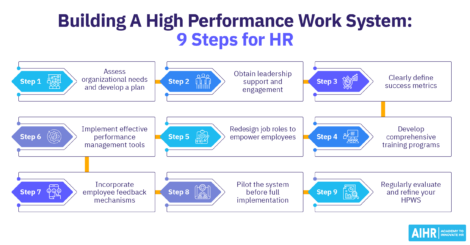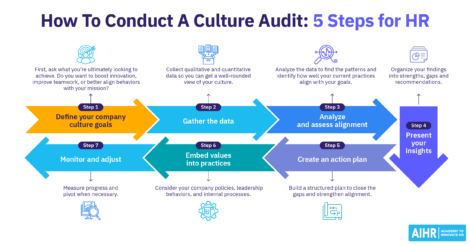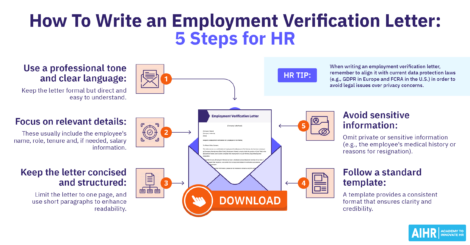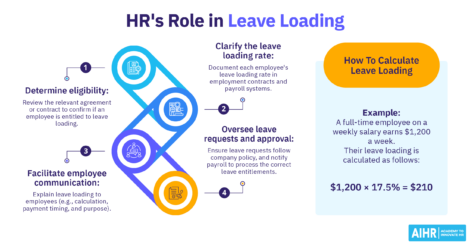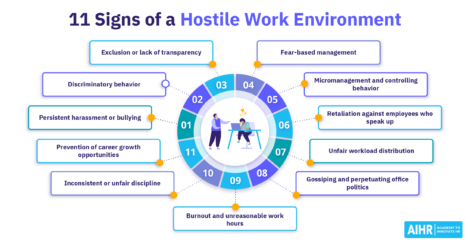What Is Organizational Development? A Complete Guide
“The greatest danger in times of turbulence is not the turbulence; it is to act with yesterday’s logic.” Management consultant Peter Drucker’s words describe why leaders need to approach organizational development as a continued effort.
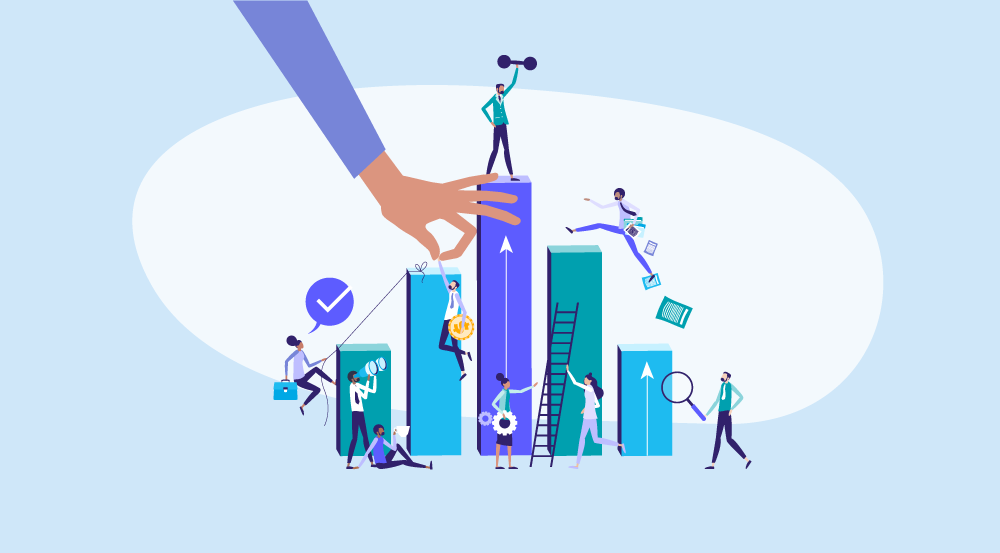
Organizational development is a complex and multilayered topic that plays a key role in driving organizational success. While many HR professionals are familiar with the term, its full scope is often less clear.
In this complete guide, we delve into organizational development, its goals, how it works, and describe some examples. By the end, you will have a foundational understanding of organizational development and its significance in building thriving workplaces.
For a quick reference to key steps and strategies, download our Organizational Development Process Cheat Sheet and start applying OD principles effectively in your organization.
Contents
What is organizational development?
Goals of organizational development
Organizational development vs. Human Resources
Examples of OD interventions
Stages of organizational development
Organizational development process
Real-life organizational development examples
Organizational development skills
Organizational development certification
FAQ
What is organizational development?
Organizational development (OD), also referred to as organization development, is a strategic approach to improving an organization’s effectiveness, adaptability, and overall health. It’s a critical and science-based process that builds organizations’ capacity to change and achieve greater success by developing, improving, and reinforcing strategies, structures, and processes.
OD involves planned interventions and initiatives designed to support growth, innovation, and cultural transformation, often through employee engagement, leadership development, and process improvement.
Here’s a closer look at the main elements of this definition (adapted from Cummings & Worley, 2009 research):
- Critical and science-based process: OD is an evidence-based and structured process. It’s not a quick fix or an experiment of trying something out to see what happens. OD uses scientific findings as input and creates a structured and controlled process in which assumptions are tested. Then it examines whether the outcomes reflect the intention of the intervention.
- Building capacity to change and achieve greater effectiveness: Organizational development is aimed at organizational effectiveness. Therefore, it has a number of (business) outcomes. These can differ between organizations, but they usually include financial performance, customer satisfaction, organizational member engagement, and an increased capacity to adapt and renew the organization. These are not always clear-cut, yet, however they are defined, they are about building a competitive advantage. We will explore these outcomes later in this article.
- Developing, improving, and reinforcing strategies, structures, and processes: Organizational development involves changes in strategy, structure, and/or processes focusing on an entire organizational system. It can be applied to the whole organization, one or more locations, or a single department.
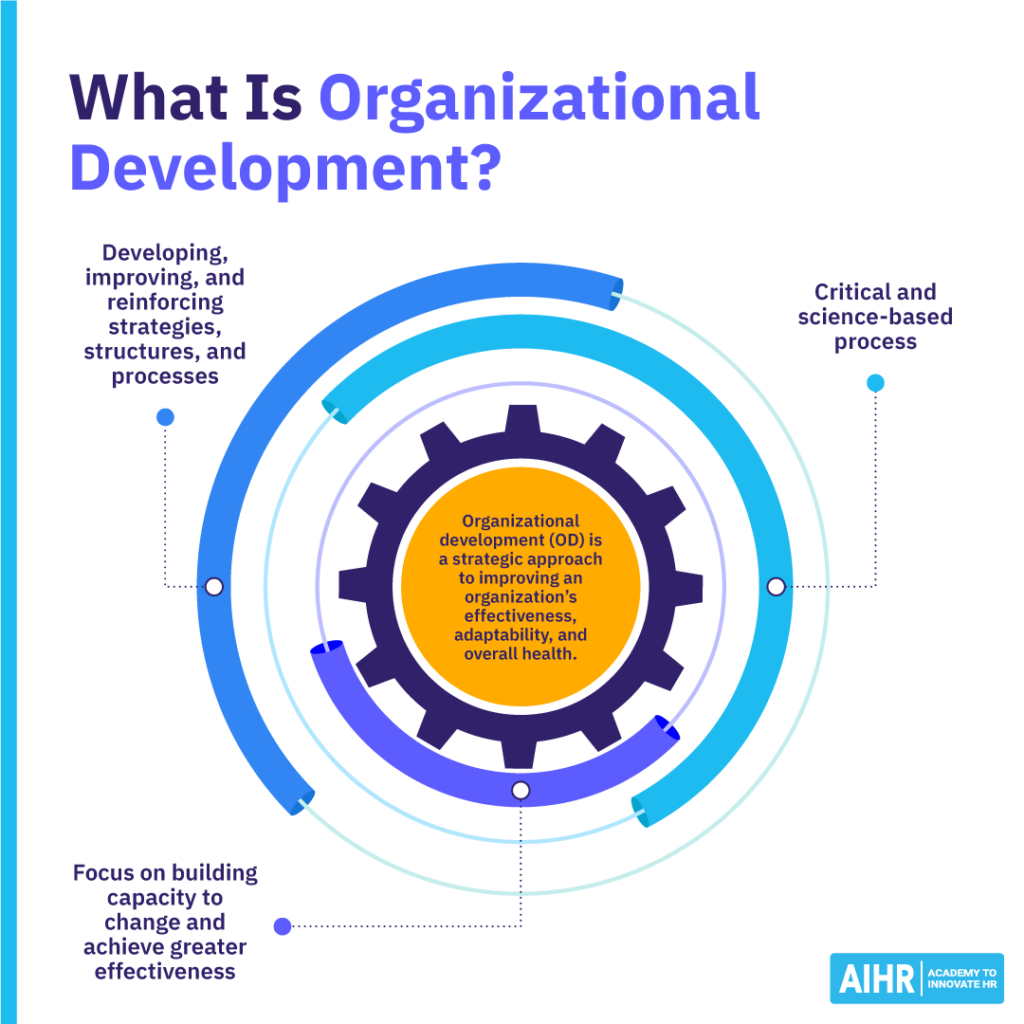
In organizational development, the company’s main stakeholders are both internal and external. Management and employees are internal stakeholders. External stakeholders include customers, investors, suppliers, communities, and governments.
Organizational design has become a trusted and needed practice in today’s business climate that is characterized by Volatility, Uncertainty, Complexity, and Ambiguity (VUCA). This plays out in many ways, including the following:
- Globalization is leading to a much greater interconnectedness and opening up organizations to worldwide opportunities and threats.
- IT is redefining traditional business models, creating innovative companies with the ability to scale their services to a worldwide audience in only a few years. For instance, Facebook reached one million users within a year of its launch, and Snapchat garnered 10 million active users in its first year. TikTok’s growth has been even more remarkable, reaching over 340 million users in the year after launching.
- Business systems are becoming better at measuring relevant data, changing the way success is measured.
- Advanced people analytics are helping to further drive organizational outcomes.
This VUCA world requires new agility from organizations. Organizational development strategies are the means to that end.
With change being a constant factor, OD is an integral approach to ensuring stability that differs from the incidental change process. OD focuses on building the organization’s ability to assess its current functioning and tweak it to achieve its goals. It is, therefore, a continuous process, whereas change processes are often temporary.
Understanding and applying organizational development principles is essential for creating a resilient and competitive business environment.
With AIHR’s Organizational Development Certificate Program, you’ll learn how to design structures, processes, and strategies that foster continuous improvement and adaptability.
Goals of organizational development
The goals of organizational development vary between organizations. In corporate companies, increasing profits is likely to be a chief concern. Within non-profits, cultural values are of high importance. And in health services, adaptability is key to maintaining good functioning.
If there were one central goal for OD, it would be to increase the organization’s competitiveness. Competitiveness is the idea that every organization has unique resources and competencies that help it win in the marketplace.
These resources include:
- People: Visionary leaders like Steve Jobs or collaborative teams like those at Google.
- Innovative products: Groundbreaking offerings like the iPhone.
- Superior service: Companies like Four Seasons Hotels provide exceptional customer experiences.
- Robust culture: Employee-focused environments exemplified by Zappos.
- Agility in market response: The capacity to swiftly adapt to changing market demands, seizing opportunities to secure revenue growth in the coming years.
OD develops aspects that help a business outperform its competition. The following sub-goals contribute to fulfilling this ultimate goal of boosted competitiveness:
- Improving efficiency and productivity: OD interventions engage employees and help them become more efficient and productive by addressing inefficiencies and equipping them with the required skills to meet changing needs.
- Enhance organizational adaptability: OD emphasizes the impact that behaviors, attitudes, beliefs, and attitudes have on the organization and how individuals, systems, and processes can encourage a more adaptable and resilient culture that can better navigate change.
- Develop leadership capacity: A key component of OD focuses on talent development. Equipping current and future leaders with new and necessary capabilities ensures a reliable leadership pipeline.
- Improve decision-making processes: Because OD is data-backed, teams can make decisions based on evidence and not assumptions. It also identifies and addresses communication breakdowns so information can flow freely to decision-makers.
Organizational development vs. Human Resources
Many OD interventions relate to Human Resource Management functions. Policies such as performance management, goal setting, appraisal, and talent management practices are all important in achieving effective organizational development.
However, whereas HRM focuses specifically on people practices, OD takes a more holistic approach. Using tools like organizational design, work design, and more traditional people interventions, OD can operate at all levels of the organization. These levels are trans-organizational, organizational, group, and individual. However, the focus is always on strategic themes, whereas HR is often more operational.
Sometimes, OD functions are located in the HR function, but not always. It may be part of a services department, corporate strategy, or internal consulting. External strategy consultants also frequently utilize OD techniques in change management projects.
Both HRM and OD have their roots in the business strategy – the mission, values, and vision of the organization. Both outline the actions needed to implement that strategy in their respective fields. In addition, many early people analytics initiatives originate from the OD department.
OD techniques are very powerful. For an HR professional, there are huge benefits to mastering them. The term “organizational development” actually emerged in the 1960s as a way to describe managing the behavioral aspects of people within organizations.
Understanding OD means you can identify which elements of core HR functions need focus in order to support the organization as a whole in becoming more efficient. OD provides an integrated way of approaching these challenges.
Check out our Learning Bite to learn everything you need to know about Organizational Development for HR!
Examples of OD interventions
Organizational development is a complex, in-depth process with different types of interventions. Using the work of Cummings and Worley (2009) as a basis, this section covers 15 organizational development interventions across four categories:
- Human process interventions
- Technostructural interventions
- HRM interventions
- Strategic change interventions.
Although this is not an exhaustive list, it aims to help you grasp this vast topic better and understand how OD relates to core HR functions.
Human process interventions
Human process interventions are change programs that relate to interpersonal relations, group, and organizational dynamics. These are some of the earliest and best-known OD interventions.
1. Individual interventions: These interventions are targeted at the individual, often aimed at improving communication with others. With these, an employee is coached on counterproductive interpersonal behaviors.
2. Group interventions: These interventions are aimed at the content, structure, or process of the group:
- The content is what the group is focused on
- The structure is how a group is designed to act on the content
- The process is how the group carries out its core tasks.
For example, a contact center focuses on taking complaints from customers. It has a hierarchical structure with a director, managers, and customer service staff. The contact center’s process is to record all complaints as quickly as possible. An intervention could be, for example, to optimize how the contact center handles complaints and only escalate a certain percentage to management based on predefined criteria.
3. Team building: Team building is the best-known OD intervention. It refers to activities that help groups improve their collaboration and task accomplishment. Examples of team-building activities are volunteering, team sports, and group games.
4. Intergroup relations interventions: Intergroup relations interventions aim to diagnose and improve the interactions, communication, and collaboration between different groups or departments in an organization. This process involves identifying problems or conflicts between groups, setting improvement priorities, and implementing solutions to foster mutual understanding and cooperation.
An intergroup relations intervention could involve facilitating a workshop between the sales and operations teams to address miscommunication and align expectations on order fulfillment timelines.
5. Large-group interventions: These interventions aim to bring together a large number of organization members and external stakeholders to work together. They may address organization-wide problems or implement changes of structure or direction.
For example, if you run a care home, you would seek feedback from service users, relatives, and staff on ways to improve the quality of life for residents. This could involve starting new activities or changing the menu options. These meetings are often referred to as “open space meetings,” “world cafes,” “future searches,” and “appreciative inquiry summits.”
Technostructural interventions
Technostructural interventions refer to change programs aimed at the technology and structure of the organization. These are becoming increasingly relevant as new technologies emerge rapidly.
6. Organizational (structural) design: An organization’s functional structure is crucial to its operation. You are likely familiar with the traditional hierarchical organizational chart. Other common structures are divisional, matrix, process, customer-centric, and network.
Key activities in organizational design are restructuring and downsizing. This involves rethinking how work is done, preparing the organization, and reshaping it around the new business processes.
7. Total quality management: Total quality management is also known as continuous process improvement, lean, and Six Sigma. It grew out of a manufacturing emphasis on quality control.
It places customer satisfaction as central to an organization’s long-term success. To achieve this, there is a strong focus on total employee involvement in the continuous improvement of products, processes, and workplace culture. Companies such as Toyota and Motorola use this intervention.
8. Job enrichment. Job enrichment is part of work design. The goal is to create a job that is interesting and challenging for the person doing it. Factors to be taken into account are skill variety, task identity, task significance, autonomy, and feedback.
Human Resource Management interventions
Human Resource Management interventions are organizational development techniques that focus on how the individual is managed. Many of these fall under HRM functions.
9. Performance management: Good performance management includes techniques such as goal setting, continuous feedback, performance appraisal, and reward systems.
10. Developing talent: This includes talent management practices like coaching, mentoring, career planning, development interventions, and management and leadership development.
11. Diversity interventions: Diversity is a source of innovation and financial outperformance. It includes age, gender, race, sexual orientation, disabilities, culture, and value orientation. These OD intervention techniques are aimed at increasing diversity.
12. Wellness interventions: Employee wellness interventions include stress management programs and employee assistance programs. They address social factors and aim for a healthy work-life balance.
Strategic change interventions
Strategic change interventions are organizational development techniques focusing on the change processes that shake the organization to its core. The OD department plays a crucial part in executing this change.
13. Transformational change: This is a process that involves changing the basic character of the organization, including how it is structured and operates. For example, Nintendo is famous for video games. However, the company was founded in 1889 to create card games. Due to changes in consumer interests, Nintendo shifted to electronic toys and later video games in the 1970s.
14. Continuous change: Continuous change is an intervention that enables organizations to improve gradually by making small incremental changes. A popular example is the learning organization. This approach places more importance on learning from mistakes and failures than punishing them.
15. Transorganizational change: Transorganizational change involves change interventions that move beyond a single organization. This includes mergers, allying, acquisitions, and strategic networking. A common type of trans-organizational change is when a company buys or merges with a competitor.
As we mentioned, this is not an exhaustive list. Techniques like financial planning, long-range forecasting, integrating technology, workforce planning, and designing appraisal systems can be added, as well as many, many more.
Stages of organizational development
Organizational Development is fundamentally about change, and like any change process, it unfolds in stages. While various authors propose different frameworks, we can generally establish the following stages of organizational development, each addressing key aspects of initiating, managing, and embedding change within an organization.
1. Entering and contracting
OD’s initial stage occurs because an organization’s leaders see a matter that needs to be addressed. Reduced revenue, impending external factors, internal conflicts, or increased employee turnover can indicate a deeper problem.
Once the problem is identified, the OD practitioner meets with management to understand the issue and assess the situation. From there, the OD expectations can be set.
2. Diagnosing
The diagnosing phase is the time to gather data and analyze the circumstances to find the root cause of the issue and determine the necessary OD steps. OD practitioners collect data to analyze and interpret the problem through observations, surveys, interviews, or by looking at currently available data from work systems. Then they present the diagnosis to the stakeholders with insight that demonstrates why the changes need to take place.
3. Intervening and taking action
The next stage is strategic planning. This step transforms the diagnosis into an action plan that includes detailed steps and which interventions will enact the change. These coordinated activities will intentionally disrupt how things are usually done.
Delineating the success criteria is a major part of the change process. Progress cannot be measured adequately without well-defined standards.
4. Evaluating and feedback
Once the organization has implemented the OD plan, it must continue to monitor it. This phase assesses if the interventions are effective and whether they need adjustments or redirection. The OD professional meets with the (internal) client to discuss the data and ensure it is interpreted correctly and consistently.
5. Termination/exit
The OD process concludes after the changes have been incorporated into day-to-day operations. A plan is set for sustaining and monitoring the transformation that supports employee concerns as they acclimate to the new systems and conditions.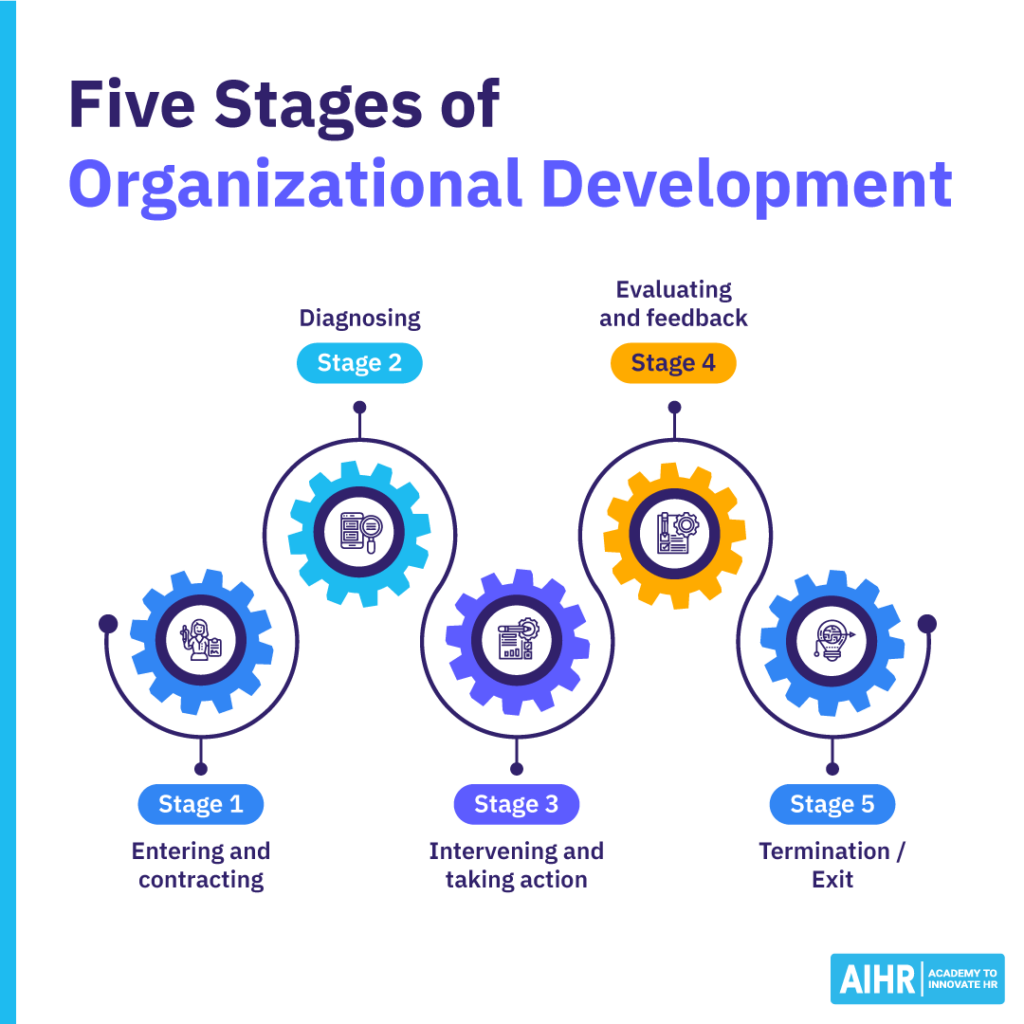
Organizational development process
While these stages might look straightforward, the organizational development process is often complex and iterative. It requires continuous feedback, adaptation, and collaboration to effectively address challenges and achieve sustainable organizational change. We will break the core aspects of OD processes down into seven steps.
The OD process is not unlike the people analytics cycle, which involves detecting a problem, gathering data, analyzing it, presenting it, and implementing new policies.
We’ll follow an example of an OD endeavor throughout these seven stages. Let’s say the X-ray department in health services spans three hospitals in a city, all run by the same organization. For decades, the organization has recruited administration staff to work at each specific hospital. However, when sickness absences occur, there is often no staff available to cover.
This sparked the need for change through the OD process, as the recurring staffing issues highlighted inefficiencies in the current system. The organization recognized the necessity of a more flexible and collaborative approach.
1. Scope out the problem (Entering and contracting stage)
including external changes, internal conflicts, complaining customers, loss of profit, a lack of innovation, high sickness absences, or employee turnover. These events are usually symptoms of a deeper problem.
In our example, the admin team at the three hospitals has problems with not having enough staff to cover sick leave. The staff are only trained to work at one particular hospital. The secondary problem is the high cost of this, due to the need to hire agency staff frequently.
2. Evaluate the current situation (Diagnosing stage)
The OD professional would review HR and financial records at the three hospitals. This would provide data on sick leave levels and the costs of using agency staff.
Different organizational development models are used to run these diagnoses. Below, you see three input-process-output (IPO) models. They help structure the different design components of organizations (note the resemblance to Galbraith’s star model). This model clearly shows the different design components that play a role at different organizational levels (i.e., organizational, group, and individual).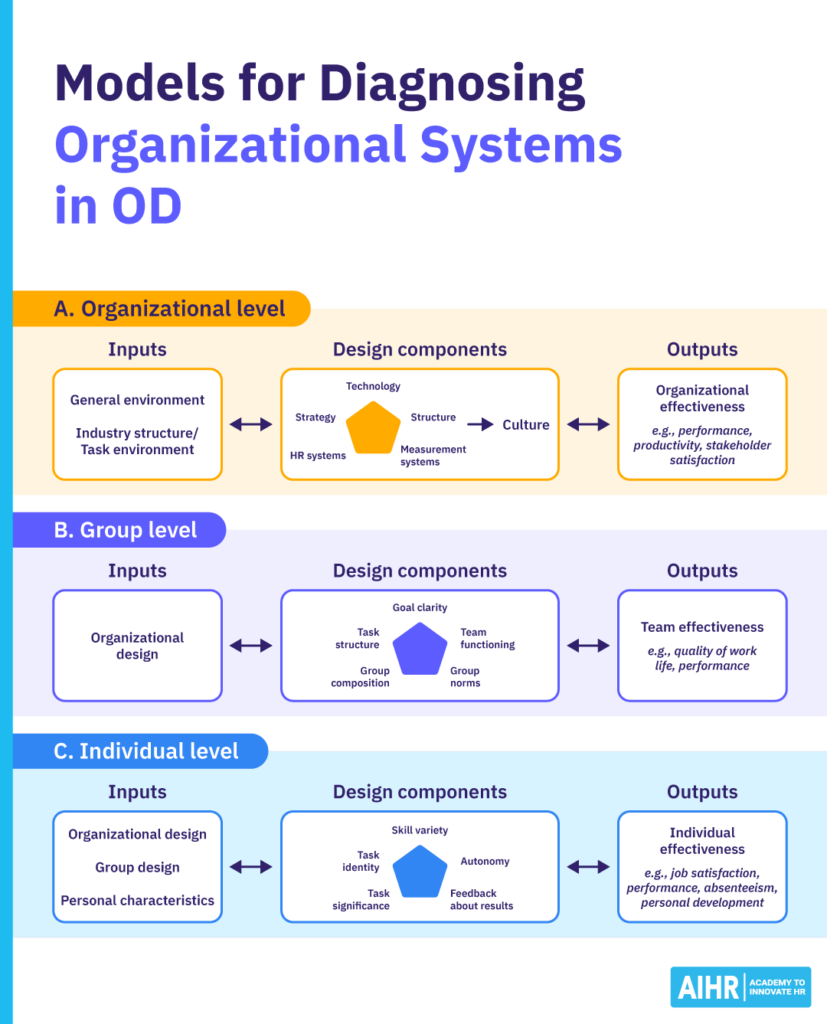
3. Collect and analyze relevant data (Diagnosing stage)
The OD practitioner may decide to interview employees in the admin team about why they take sick leave and if any aspects of the organization impact doing so.
Data collection is often time-consuming but critical for a project’s success. Important factors to remember are confidentiality, anonymity, a clear purpose, observer-expectancy bias, and the Hawthorne effect.
Observer-expectancy bias is when the responses of the observed are influenced by the observer’s expectations. The Hawthorne effect refers to the famous Hawthorne studies where subjects behaved differently purely because they were being observed.
Another effect to keep in mind is a regression to the mean. This refers to the statistical phenomenon where extreme events or outlier situations tend to move closer to the average or typical state over time. Essentially, when something is unusually high or low, it is likely to become less extreme in subsequent occurrences simply due to natural variation.
For example, if a consultant is brought in during a crisis, the severity of the crisis may decrease over time—not necessarily because of the consultant’s interventions but because extreme situations often stabilize or improve on their own. This means that a dire situation is less likely to spiral further out of control and more likely to return to a more average state, illustrating the concept of regression to the mean.
So, bringing in a consultant during extreme circumstances decreases their severity simply because time passes. The situation is less likely to go from dire to even worse and more likely to go from really bad to just bad—hence, regression to the mean.
4. Consult findings with stakeholders (Intervening and taking action stage)
In this phase, it is key for the OD consultant to give information back to the client in an understandable and accomplishable way. It must be relevant, descriptive, verifiable, timely, limited, significant, comparative, and spur action. Techniques like storytelling and visualization can be used to do this successfully.
The OD consultant could present their key findings to management via a slide deck. They could also provide a detailed report, which management can delve into more deeply before deciding which changes to implement at the hospitals.
5. Design intervention and implement change (Intervening and taking action stage)
After providing the client with feedback, it’s time to create an intervention. This intervention must fit the organization’s needs and be based on causal knowledge of outcomes. In addition, the organization needs to be able to absorb the changes successfully.
A possible intervention the organization could implement at the three hospitals is to train all current and new staff to work across all hospital locations. The criteria for success would be less use of agency staff and more in-house employees covering sick leave across the hospitals.
6. Evaluate and monitor the change (Evaluating and feedback stage)
The next phase is about executing the change intervention. Estimations put the failure rate of change between 50-70%. Even though this is not entirely true, no one can doubt that change is hard.
Effective change management involves motivating change, creating a vision, developing support, managing the transition, and sustaining momentum. Well-known change models include John Kotter’s eight steps to transforming your organization.
At the hospitals, not all staff will likely want to shift from working at one site to working across three. Some staff could quit. Management will need to think carefully about how to convince staff to come on board to support this change.
7. Institutionalization of the change/Change has become the new norm (Termination/exit stage)
Once a system has been implemented, opportunities for improvement start to show. Addressing them and making incremental changes will improve user and employee experience.
The need for all staff to work across three hospitals may require the organization to find a way to reduce travel costs for employees. This could be done by paying staff a bit more to offset the added costs or introducing a low-cost or free shuttle bus for staff.
Lastly, effective organizational development interventions measure their own success and are created in a way that enables comparison between the state of affairs before and after.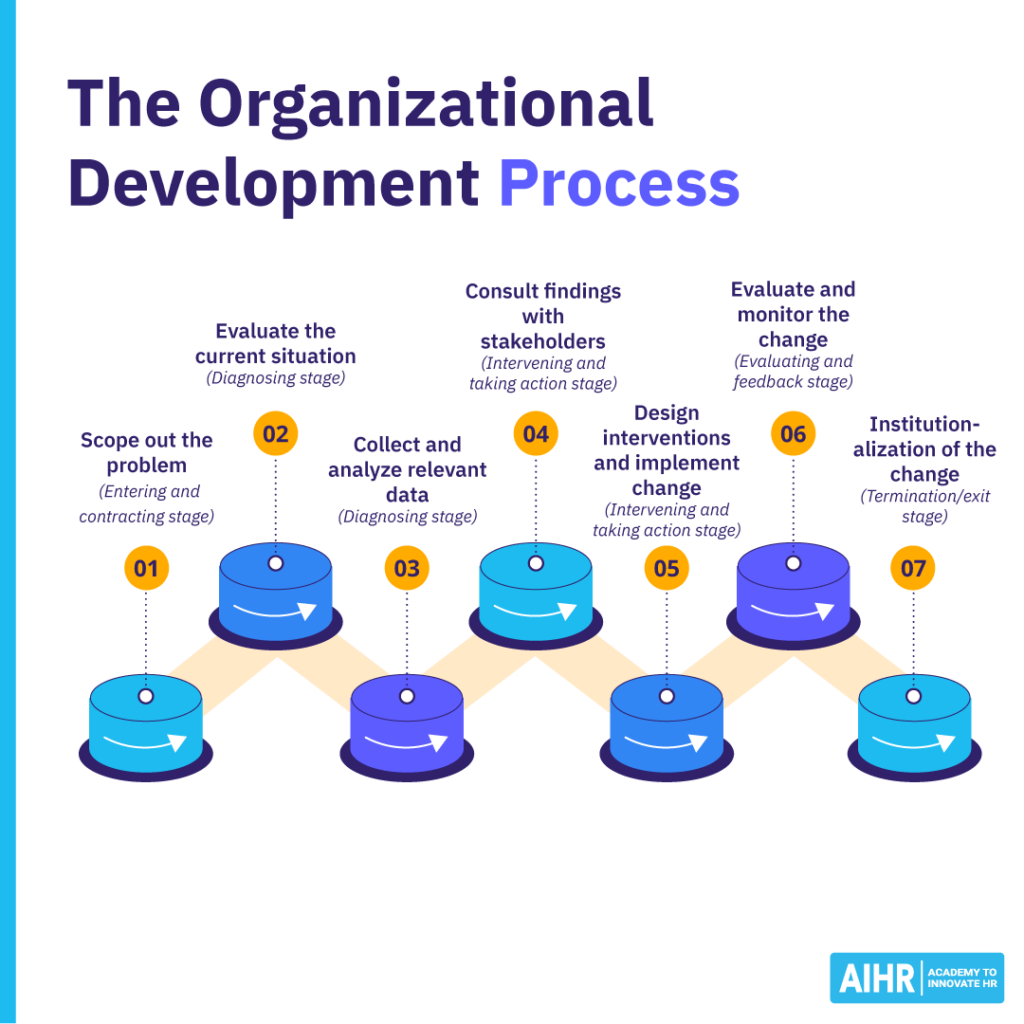
Real-life organizational development examples
Seeing how different companies have applied organizational development strategies is a helpful way to understand how they work in practice.
Let’s look at three examples:
Creating a learning culture at Southwest Airlines
Before the end of 2020, Southwest Airlines leaders were not required to participate in leadership development beyond their initial training. This meant that the longer leaders stayed with the company, the more outdated their learning became.
The airline implemented a new leadership development strategy to create a learning culture with ongoing training on new techniques and skill sharpening. Leaders must commit to attending several learning events each year and have embraced these opportunities to expand their knowledge and abilities.
Evolving the employee value proposition at Procter & Gamble
After over 185 years in business, multinational consumer goods corporation Procter & Gamble Company (P&G) leaders understood that they needed to make certain changes to stay current. This includes how they reach potential employees.
P&G’s previous employee value proposition reads like a checklist of what to expect. After consulting with team members and formulating a fresh approach, they launched a reimagined EVP.
It’s depicted as an equation based on words from P&G’s Purpose Values and Principles statement, “Our quest for mutual success is what ties us together.” It’s called “P&G + Me = Mutual Success.” The new version is an interactive narrative about the company’s central issues and employees.
Rebranding Dunkin’
The Dunkin’ Donuts restaurant chain rebranded in 2019 by shortening its name to Dunkin’. Inspired by the popularity of its coffee, leaders expanded from donuts to tap into Starbucks’ market share.
At the time, Dunkin’ U.S. President David Hoffmann explained, “Our new branding is one of many things we are doing as part of our blueprint for growth…”
Despite the name change, the company kept the same font and colors from the original 1973 logo to remain recognizable. However, dropping the word “donuts” took the emphasis off pastries and broadened its brand to customers who may not be keen on donuts.
Organizational development skills
Practicing organizational development requires certain capabilities. Devoted OD specialists must acquire these skills and gain experience in them. These capabilities are also advantageous for HR professionals who play a key role in driving organizational change.
These skills enable OD and HR professionals to effectively diagnose issues, facilitate collaboration, design and implement change initiatives, and ensure the long-term success of development efforts within their organizations.
Key organizational development skills include:
- Business acumen: The ability to comprehend and navigate business situations. It involves a thorough understanding of how a business operates, what its mission and goals are, and how its different functions relate to each other. A person with business acumen is financially literate and a strategic thinker who makes informed, effective decisions.
- Change management: The ability to guide others through transition. Change management requires a blend of technical and interpersonal skills such as strategic planning, leadership, analytical thinking, communication, mediation, and empathy.
- Project management: The ability to oversee projects from inception to completion. Successful project management entails organization, time management, communication, negotiation, problem-solving, and risk management capabilities. Familiarity with the project subject matter and project management tools and software are also key.
- Data analysis: Proficiency in collecting, analyzing, and interpreting data. Because OD is an evidence-based process, it relies on data and its interpretation for decision-making.
Organizational development certification
Becoming an OD consultant often requires a Bachelor’s degree. Relevant degrees include training and development, Human Resources, or instructional design. Related work experience, such as in HR, is also useful.
Holding an organizational development certification demonstrates an understanding of the field and makes a strong OD job candidate. The Organizational Development Certificate Program by AIHR is designed specifically for HR professionals who want to learn how and when to apply OD techniques in their work.
A final word
One of the most common barriers to implementing organizational development is the complexity it can present to an organization’s leaders. HR professionals with a solid grasp of OD principles are uniquely positioned to bridge this gap and lead meaningful and sustainable change.
At its core, organizational development is about empowering an organization to achieve its strategic goals through the engagement and optimization of its most valuable asset—its people. By mastering OD practices, HR professionals can not only boost the effectiveness of the HR function itself but also drive improvements that impact the entire organization. Ultimately, a commitment to OD fosters a culture of continuous growth, resilience, and excellence.
To continue learning about organization development, we highly recommend Cummings & Worley’s 2009 book Organizational Development & Change.
FAQ
Organizational development is a critical and science-based process that helps organizations build their capacity to change and achieve greater effectiveness by developing, improving, and reinforcing strategies, structures, and processes.
Many OD interventions relate to HRM, including performance and talent management interventions. However, while HRM focuses specifically on people practices, OD takes a more holistic approach, examining individuals, teams, and organizational systems.
Organizational development in HR involves changes and improvement of the processes and structures that are part of HR’s responsibility. These include processes and systems related to performance management, talent management, diversity, employee wellness, etc.
The five stages of organizational development are as follows:
– Entering and contracting (Assessing the situation and exploring the problem)
– Diagnosing (Data collection and fact-finding)
– Intervening and taking action (Interpreting data and creating an action plan for interventions)
– Evaluating and feedback (Monitoring outcomes and adjusting)
– Termination/exit (Finishing up and ensuring changes are sustainable)
Learn more
Related articles
Are you ready for the future of HR?
Learn modern and relevant HR skills, online







